Analysis of Water Source Conservation Driving Factors Based on Machine Learning
Abstract
1. Introduction
2. Methods and Materials
2.1. Research Framework
2.2. Spatiotemporal Evolution Analysis of Water Retention
InVEST Model
2.3. Analysis Methods for Water Retention Driving Factors
2.3.1. Machine Learning Model
- (1)
- CatBoost
- (2)
- LightGBM
- (3)
- XGBoost
- (4)
- Random Forest
2.3.2. SHAP Analysis
2.3.3. PDP Correlation Analysis
2.4. Data Sources
2.4.1. Water Conservation Data Sources
2.4.2. Impact Factor Data Sources
3. Study Area Overview
4. Results
4.1. Spatiotemporal Evolution Analysis of Water Conservation
4.1.1. Verification of Water Retention Simulation Accuracy
4.1.2. Spatial Evolution Characteristics of Water Conservation
4.1.3. Temporal Evolution of Water Conservation in Different Land Use Types
4.2. Driving Factors Analysis
4.2.1. Selection of Impact Factors and Data Preprocessing
4.2.2. Optimal Model Selection
4.2.3. Importance Ranking and Impact Analysis of Influence Factors
4.2.4. Single-Factor Importance Ranking and Impact Analysis
4.2.5. Impact of Factor Interactions on Water Conservation
- (1)
- In the precipitation range of 0.26 to 0.45 mm, the interactive effect of precipitation and temperature on water conservation shows a decreasing trend, likely due to increased soil saturation reducing precipitation’s positive impact. In contrast, when precipitation approaches 0 or 0.6 mm and temperature rises, water conservation capacity significantly increases, possibly related to soil conditions in unsaturated precipitation areas. Under rising temperatures, soil conditions favor plant growth, increasing plant water content and enhancing water conservation function.
- (2)
- In the precipitation–soil type interaction, with 0.2 and 0.22 as boundaries, the interactive effect on water conservation reaches critical points. Beyond these points, as precipitation and soil type values increase, their interactive contribution to water retention increases.
- (3)
- Within the 0.70–0.75 range of the normalized vegetation index, the interactive effect of temperature and vegetation index on water conservation decreases. Outside this range, water conservation improves with rising temperatures, indicating that temperature increase may become the primary factor affecting water retention under high vegetation coverage.
- (4)
- In the temperature–elevation interaction, when soil type is at a specific value (approximately 0.3), temperature changes have an insignificant impact on watershed water retention. However, when elevation exceeds this threshold, the temperature–elevation interaction begins to significantly affect water conservation, as increased elevation leads to more precipitation, promoting vegetation growth. Additionally, rising temperatures stimulate vegetation growth and water content, further increasing water conservation.
- (5)
- The interactions between soil type and both precipitation and plant water content are more complex. Notably, the interaction between soil type and plant water content is highly significant, offering new perspectives for urban green space planning and urban blue-green pattern construction.
5. Discussion
5.1. Water Conservation Calculation
5.2. Future Water Conservation Simulation
5.3. Limitations
6. Conclusions
- (1)
- Water conservation in the Yiluo River Basin experienced fluctuations, peaking in 2003 and reaching its lowest point in 2013. Areas with extensive forest coverage, such as Luanchuan County and Song County, maintained high water conservation capacity. The watershed’s water conservation mainly came from forest land, cropland, and grassland. Furthermore, forest land contributed over 60% of the water conservation in the Yiluo River Basin. Conversely, central urban areas along both banks of the Luo River saw reduced water conservation capacity due to the rapid expansion of impervious surfaces during urbanization.
- (2)
- SHAP and PDP analysis and quantification of driving factors showed that annual rainfall, plant water content, and soil type are the main factors affecting water conservation. Through the single-factor PDP analysis, soil type in particular showed a complex nonlinear effect on water conservation, as different soil types vary in water retention and permeability capabilities. Loose soil texture enhances permeability and adsorption capacity, improving water conservation function; conversely, dense soil impedes water retention. These factors show nonlinear relationships with water conservation. PDP analysis for two-factor interaction detection also found that temperature shows the most significant interactive effects with precipitation, elevation, normalized vegetation index, and evapotranspiration, displaying similar trends.
- (3)
- This study did not fully analyze dynamic impact factors of water conservation, lacking a discussion of temporal series for dynamic factors. At the same time, the exploration of socioeconomic factors should be supplemented in future research.
Author Contributions
Funding
Conflicts of Interest
References
- Tian, P.; Lu, H.; Feng, W.; Guan, Y.; Xue, Y. Large decrease in streamflow and sediment load of Qinghai–Tibetan Plateau driven by future climate change: A case study in Lhasa River Basin. Catena 2020, 187, 104340. [Google Scholar] [CrossRef]
- Hu, W.; Li, G.; Gao, Z.; Jia, G.; Wang, Z.; Li, Y. Assessment of the impact of the Poplar Ecological Retreat Project on water conservation in the Dongting Lake wetland region using the InVEST model. Sci. Total Environ. 2020, 733, 139423. [Google Scholar] [CrossRef] [PubMed]
- Costanza, R.; d’Arge, R.; De Groot, R.; Farber, S.; Grasso, M.; Hannon, B.; Limburg, K.; Naeem, S.; O’Neill, R.V.; Paruelo, J.; et al. The value of the world’s ecosystem services and natural capital. Nature 1997, 387, 253–260. [Google Scholar] [CrossRef]
- Nedkov, S.; Campagne, S.; Borisova, B.; Krpec, P.; Prodanova, H.; Kokkoris, I.P.; Hristova, D.; Clec’h, S.L.; Santos-Martin, F.; Burkhard, B.; et al. Modeling water regulation ecosystem services: A review in the context of ecosystem accounting. Ecosyst. Serv. 2022, 56, 101458. [Google Scholar] [CrossRef]
- Bai, Y.; Ochuodho, T.O.; Yang, J. Impact of land use and climate change on water-related ecosystem services in Kentucky, USA. Ecol. Indic. 2019, 102, 51–64. [Google Scholar] [CrossRef]
- Jia, Y.; Jin, J.; Wang, Y.; Guo, X.; Du, E.; Wang, G. Evaluating the Spatiotemporal Distributions of Water Conservation in the Yiluo River Basin under a Changing Environment. Water 2024, 16, 2320. [Google Scholar] [CrossRef]
- Zhao, Q.; Ding, Y.; Wang, J.; Gao, H.; Zhang, S.; Zhao, C.; Xu, J.; Han, H.; Shangguan, D. Projecting climate change impacts on hydrological processes on the Tibetan Plateau with model calibration against the glacier inventory data and observed streamflow. J. Hydrol. 2019, 573, 60–81. [Google Scholar] [CrossRef]
- Wang, C.; Hou, Y.; Zhang, J.; Chen, W. Assessing the groundwater loss risk in Beijing based on ecosystem service supply and demand and the influencing factors. Sci. Total Environ. 2023, 872, 162255. [Google Scholar] [CrossRef] [PubMed]
- Chen, J.M.; Chen, X.; Ju, W.; Geng, X. Distributed hydrological model for mapping evapotranspiration using remote sensing inputs. J. Hydrol. 2005, 305, 15–39. [Google Scholar] [CrossRef]
- Donohue, R.J.; Roderick, M.L.; McVicar, T.R. Roots, storms and soil pores: Incorporating key ecohydrological processes into Budyko’s hydrological model. J. Hydrol. 2012, 436–437, 35–50. [Google Scholar] [CrossRef]
- Li, M.; Liang, D.; Xia, J.; Song, J.; Cheng, D.; Wu, J.; Cao, Y.; Sun, H.; Li, Q. Evaluation of water conservation function of Danjiang River Basin in Qinling Mountains, China based on InVEST model. J. Environ. Manag. 2021, 286, 112212. [Google Scholar] [CrossRef]
- Zhang, G.; Wu, Y.; Li, H.; Zhao, W.; Wang, F.; Chen, J.; Sivakumar, B.; Liu, S.; Qiu, L.; Wang, W. Assessment of water retention variation and risk warning under climate change in an inner headwater basin in the 21st century. J. Hydrol. 2022, 615, 128717. [Google Scholar] [CrossRef]
- Wang, Y.; Wang, H.; Liu, G.; Zhang, J.; Fang, Z. Factors driving water yield ecosystem services in the Yellow River Economic Belt, China: Spatial heterogeneity and spatial spillover perspectives. J. Environ. Manag. 2022, 317, 115477. [Google Scholar] [CrossRef]
- Cong, W.; Sun, X.; Guo, H.; Shan, R. Comparison of the SWAT and InVEST models to determine hydrological ecosystem service spatial patterns, priorities and trade-offs in a complex basin. Ecol. Indic. 2020, 112, 106089. [Google Scholar] [CrossRef]
- Hu, W.; Li, G.; Li, Z. Spatial and temporal evolution characteristics of the water conservation function and its driving factors in regional lake wetlands—Two types of homogeneous lakes as examples. Ecol. Indic. 2021, 130, 108069. [Google Scholar] [CrossRef]
- Sun, J.; Ni, C.; Wang, M. Analysis of Water Conservation Trends and Drivers in an Alpine Region: A Case Study of the Qilian Mountains. Remote Sens. 2023, 15, 4611. [Google Scholar] [CrossRef]
- Luo, Y.; Cao, Z.; Zhao, X.; Wu, C. Climate Change Contributions to Water Conservation Capacity in the Upper Mekong River Basin. Water 2024, 16, 2601. [Google Scholar] [CrossRef]
- Liu, Z.; Di, Z.; Zhang, W.; Sun, H.; Tian, X.; Meng, H.; Liu, J. The Historical and Future Variations of Water Conservation in the Three-River Source Region (TRSR) Based on the Soil and Water Assessment Tool Model. Atmosphere 2024, 15, 889. [Google Scholar] [CrossRef]
- Wang, J.F.; Zhang, T.L.; Fu, B.J. A measure of spatial stratified heterogeneity. Ecol. Indic. 2016, 67, 250–256. [Google Scholar] [CrossRef]
- Wang, J.; Xu, C. Geodetector: Principle and Prospective. Acta Geogr. Sin. 2017, 72, 116–134. [Google Scholar] [CrossRef]
- Xue, J.; Li, Z.; Du, F.; Ruan, J.; Gui, J. Dynamics changes and prediction of ecosystem services in the Qinghai-Tibet Plateau, western China. Glob. Ecol. Conserv. 2023, 47, e02674. [Google Scholar] [CrossRef]
- Zhao, G.; Tian, S.; Liang, S.; Jing, Y.; Chen, R.; Wang, W.; Han, B. Dynamic evolution trend and driving mechanisms of water conservation in the Yellow River Basin, China. Sci. Rep. 2024, 14, 26304. [Google Scholar] [CrossRef] [PubMed]
- Li, Y.; Chen, P.; Niu, Y.; Liang, Y.; Wei, T. Dynamics and attributions of ecosystem water yields in China from 2001 to 2020. Ecol. Indic. 2022, 143, 109373. [Google Scholar] [CrossRef]
- Lang, Y.; Song, W.; Deng, X. Projected land use changes impacts on water yields in the karst mountain areas of China. Phys. Chem. Earth Parts A/B/C 2018, 104, 66–75. [Google Scholar] [CrossRef]
- Wang, J.; Wu, T.; Li, Q.; Wang, S. Quantifying the effect of environmental drivers on water conservation variation in the eastern Loess Plateau, China. Ecol. Indic. 2021, 125, 107493. [Google Scholar] [CrossRef]
- Hu, J.; Wu, Y.; Wang, L.; Sun, P.; Zhao, F.; Jin, Z.; Wang, Y.; Qiu, L.; Lian, Y. Impacts of land-use conversions on the water cycle in a typical watershed in the southern Chinese Loess Plateau. J. Hydrol. 2021, 593, 125741. [Google Scholar] [CrossRef]
- Gong, S.; Xiao, Y.; Xiao, Y.; Zhang, L.; Ouyang, Z. Driving forces and their effects on water conservation services in forest ecosystems in China. Chin. Geogr. Sci. 2017, 27, 216–228. [Google Scholar] [CrossRef]
- Li, Y.; Luo, H. Trade-off/synergistic changes in ecosystem services and geographical detection of its driving factors in typical karst areas in southern China. Ecol. Indic. 2023, 154, 110811. [Google Scholar] [CrossRef]
- Sun, L.; Yu, H.; Sun, M.; Wang, Y. Coupled impacts of climate and land use changes on regional ecosystem services. J. Environ. Manag. 2023, 326, 116753. [Google Scholar] [CrossRef]
- Gao, X.; Huang, X.X.; Chang, S.H.; Dang, Q.W.; Wen, R.Y.; Lo, K.; Li, J.; Yan, A. Long-term improvements in water conservation functions at Qilian Mountain National Park, northwest China. J. Mt. Sci. 2023, 20, 2885–2897. [Google Scholar] [CrossRef]
- Wang, Y.; Ye, A.; Peng, D.; Miao, C.; Di, Z.; Gong, W. Spatiotemporal variations in water conservation function of the Tibetan Plateau under climate change based on InVEST model. J. Hydrol. Reg. Stud. 2022, 41, 101064. [Google Scholar] [CrossRef]
- Guo, Y.; Wu, Z.; Zheng, Z.; Li, X. An optimal multivariate-stratification geographical detector model for revealing the impact of multi-factor combinations on the dependent variable. GISci. Remote Sens. 2024, 61, 2422941. [Google Scholar] [CrossRef]
- Wang, J.; Haining, R.; Zhang, T.; Xu, C.; Hu, M.; Yin, Q.; Li, L.; Zhou, C.; Li, G.; Chen, H. Statistical modeling of spatially stratified heterogeneous data. Ann. Am. Assoc. Geogr. 2024, 114, 499–519. [Google Scholar] [CrossRef]
- Chen, G.; Zuo, D.; Xu, Z.; Wang, G.; Han, Y.; Peng, D.; Pang, B.; Abbaspour, K.C.; Yang, H. Changes in water conservation and possible causes in the Yellow River Basin of China during the recent four decades. J. Hydrol. 2024, 637, 131314. [Google Scholar] [CrossRef]
- Zhu, J.J.; Yang, M.; Ren, Z.J. Machine learning in environmental research: Common pitfalls and best practices. Environ. Sci. Technol. 2023, 57, 17671–17689. [Google Scholar] [CrossRef] [PubMed]
- Wang, Z.; Fu, B.; Wu, X.; Wang, S.; Li, Y.; Feng, Y.; Zhang, L.; Hu, Y.; Cheng, L.; Li, B. Distinguishing trajectories and drivers of vegetated ecosystems in China’s Loess Plateau. Earth’s Future 2024, 12, e2023EF003769. [Google Scholar] [CrossRef]
- Yuan, Y.; Li, C.; Geng, X.; Yu, Z.; Fan, Z.; Wang, X. Natural-anthropogenic environment interactively causes the surface urban heat island intensity variations in global climate zones. Environ. Int. 2022, 170, 107574. [Google Scholar] [CrossRef]
- Quan, Y.; Hutjes, R.W.; Biemans, H.; Zhang, F.; Chen, X.; Chen, X. Patterns and drivers of carbon stock change in ecological restoration regions: A case study of upper Yangtze River Basin, China. J. Environ. Manag. 2023, 348, 119376. [Google Scholar] [CrossRef] [PubMed]
- Shapley, L.S. 17. A value for n-person games. In Contributions to the Theory of Games, Volume II; Princeton University Press: Princeton, NJ, USA, 1953; pp. 307–318. ISBN 9781400881970. [Google Scholar] [CrossRef]
- Zhang, L.; Guo, Z.; Qi, S.; Zhao, T.; Wu, B.; Li, P. Landslide susceptibility evaluation and determination of critical influencing factors in eastern Sichuan mountainous area, China. Ecol. Indic. 2024, 169, 112911. [Google Scholar] [CrossRef]
- Zhou, B.; Chen, G.; Yu, H.; Zhao, J.; Yin, Y. Revealing the Nonlinear Impact of Human Activities and Climate Change on Ecosystem Services in the Karst Region of Southeastern Yunnan Using the XGBoost–SHAP Model. Forests 2024, 15, 1420. [Google Scholar] [CrossRef]
- Wang, Q.; Wang, X.; Zhou, Y.; Liu, D.; Wang, H. The dominant factors and influence of urban characteristics on land surface temperature using random forest algorithm. Sustain. Cities Soc. 2022, 79, 103722. [Google Scholar] [CrossRef]
- Zhou, S.; Jia, W.; Wang, M.; Liu, Z.; Wang, Y.; Wu, Z. Synergistic assessment of multi-scenario urban waterlogging through data-driven decoupling analysis in high-density urban areas: A case study in Shenzhen, China. J. Environ. Manag. 2024, 369, 122330. [Google Scholar] [CrossRef]
- Gan, R.; Xu, M.; Yang, F.; Zuo, Q.; Zhang, X. The assessment of baseflow separation method and baseflow characteristics in the Yiluo River basin, China. Environ. Earth Sci. 2022, 81, 323. [Google Scholar] [CrossRef]
- Yao, B.; Niu, C.W.; Jia, Y.W.; Yan, X.; Wang, D.D. Evolution of precipitation, temperature and runoff in the Yellow River water conservation area over the past 60 a and its influence on water conservation. Acta Mt. Sin. 2023, 41, 41–55+18. [Google Scholar] [CrossRef]
- Xue, J.; Li, Z.; Feng, Q.; Gui, J.; Zhang, B. Construction of ecological conservation pattern based on ecosystem services of Three River Headwaters, Western China. Glob. Ecol. Conserv. 2023, 44, e02491. [Google Scholar] [CrossRef]
- Dennedy-Frank, P.J.; Muenich, R.L.; Chaubey, I.; Ziv, G. Comparing two tools for ecosystem service assessments regarding water resources decisions. J. Environ. Manag. 2016, 177, 331–340. [Google Scholar] [CrossRef]
- Prokhorenkova, L.; Gusev, G.; Vorobev, A.; Dorogush, A.V.; Gulin, A. CatBoost: Unbiased boosting with categorical features. In Proceedings of the Advances in Neural Information Processing Systems 31 (NeurIPS 2018), Montréal, QC, Canada, 3–8 December 2018; Volume 31. [Google Scholar] [CrossRef]
- Li, Z. Extracting spatial effects from machine learning model using local interpretation method: An example of SHAP and XGBoost. Comput. Environ. Urban Syst. 2022, 96, 101845. [Google Scholar] [CrossRef]
- Li, Z.; Shi, H.; Yang, X.; Tang, H. Investigating the nonlinear relationship between surface solar radiation and its influencing factors in North China Plain using interpretable machine learning. Atmos. Res. 2022, 280, 106406. [Google Scholar] [CrossRef]
- Rui, J. Exploring the association between the settlement environment and residents’ positive sentiments in urban villages and formal settlements in Shenzhen. Sustain. Cities Soc. 2023, 98, 104851. [Google Scholar] [CrossRef]
- Yang, J.; Huang, X. The 30 m Annual Land Cover Datasets and Its Dynamics in China from 1990 to 2021. Available online: https://doi.org/10.5281/zenodo.5816591 (accessed on 2 February 2024).
- The National Tibetan Plateau Data Center. Available online: https://data.tpdc.ac.cn (accessed on 5 February 2024).
- Yan, F.; Shangguan, W.; Zhang, J.; Hu, B. Depth-to-bedrock map of China at a spatial resolution of 100 m. Sci. Data 2020, 7, 2. [Google Scholar] [CrossRef] [PubMed]
- Zhou, W.; Liu, G.; Pan, J.; Feng, X. Distribution of available soil water capacity in China. J. Geogr. Sci. 2005, 15, 3–12. [Google Scholar] [CrossRef]
- Harmonized World Soils Database Version 2.0. Available online: https://gaez.fao.org/pages/hwsd (accessed on 7 February 2024).
- Resources and Environmental Sciences, Chinese Academy of Sciences. Available online: http://www.resdc.cn (accessed on 12 February 2024).
- Earth System Grid Federation. Available online: https://esgf-node.llnl.gov/projects/cmip6/ (accessed on 12 April 2024).
- Luo, M.; Hu, G.; Chen, G.; Liu, X.; Hou, H.; Li, X. 1 km land use/land cover change of China under comprehensive socioeconomic and climate scenarios for 2020–2100. Sci. Data 2022, 9, 110. [Google Scholar] [CrossRef] [PubMed]
- Han, Y.; Zuo, D.; Xu, Z.; Wang, G.; Peng, D.; Pang, B.; Yang, H. Attributing the Impacts of Vegetation and Climate Changes on the Spatial Heterogeneity of Terrestrial Water Storage over the Tibetan Plateau. Remote Sens. 2022, 15, 117. [Google Scholar] [CrossRef]
- Guan, D.; Chen, S.; Zhang, Y.; Liu, Z.; Peng, G.; Zhou, L. Influencing factors and the establishment of a basin ecological compensation mechanism from the perspective of water conservation: A case study of the upper Yangtze River in China. J. Clean. Prod. 2024, 456, 142332. [Google Scholar] [CrossRef]
- Li, M.; Di, Z.; Yao, Y.; Ma, Q. Variations in water conservation function and attributions in the Three-River Source Region of the Qinghai–Tibet Plateau based on the SWAT model. Agric. For. Meteorol. 2024, 349, 109956. [Google Scholar] [CrossRef]
- Gao, J.; Shi, Y.; Zhang, H.; Chen, X.; Zhang, W.; Shen, W.; Xiao, T.; Zhang, Y. China Regional 250 m Normalized Difference Vegetation Index Data Set (2000–2023). National Tibetan Plateau/Third Pole Environment Data Center. Available online: https://cstr.cn/18406.11.Terre.tpdc.300328 (accessed on 2 March 2024).
- NASA EOSDIS Land Processes Distributed Active Archive Center. Available online: https://doi.org/10.5067/MODIS/MOD17A3HGF.061 (accessed on 3 March 2024).
- National Earth System Science Data Center, National Science & Technology Infrastructure of China. Available online: http://www.geodata.cn (accessed on 2 February 2024).
- Zuo, D.; Chen, G.; Wang, G.; Xu, Z.; Han, Y.; Peng, D.; Pang, B.; Abbaspour, K.C.; Yang, H. Assessment of changes in water conservation capacity under land degradation neutrality effects in a typical watershed of Yellow River Basin, China. Ecol. Indic. 2023, 148, 110145. [Google Scholar] [CrossRef]
- Huang, Y.; He, Z.; Zhang, X.; Li, J. Study on Environmental Impact of Integrated Planning in Yiluo River Basin; Yellow River Conservancy Press: Zhengzhou City, China, 2019; ISBN 9787550925656. [Google Scholar]
- Hou, J.; Yan, D.; Qin, T.; Liu, S.; Yan, S.; Li, J.; Abebe, S.A.; Cao, X. Evolution and attribution of the water yield coefficient in the Yiluo river basin. Front. Environ. Sci. 2022, 10, 1067318. [Google Scholar] [CrossRef]
- Wang, J.; Zhou, J.; Ma, D.; Zhao, X.; Wei, W.; Liu, C.; Zhang, D.; Wang, C. Impact of ecological restoration project on water conservation function of qilian mountains based on inVEST model—A case study of the upper reaches of Shiyang River Basin. Land 2023, 12, 1850. [Google Scholar] [CrossRef]
- Bhowmik, R.; Sharif, A.; Anwar, A.; Syed, Q.R.; Cong, P.T.; Ha, N.N. Does environmental policy stringency alter the natural resources-emissions nexus? Evidence from G-7 countries. Geosci. Front. 2024, 15, 101874. [Google Scholar] [CrossRef]
- Sen, P.K. Estimates of the regression coefficient based on Kendall’s tau. J. Am. Stat. Assoc. 1968, 63, 1379–1389. [Google Scholar] [CrossRef]
- Cui, J.; Ding, J.; Lian, X.; Wei, Z.; Li, S.; Peng, J.; Poyatos, R.; Wang, T.; Piao, S. Observational constraints and attribution of global plant transpiration changes over the past four decades. Geophys. Res. Lett. 2024, 51, e2024GL108302. [Google Scholar] [CrossRef]
- Guo, C.; Gao, J.; Zhou, B.; Yang, J. Factors of the ecosystem service value in water conservation areas considering the natural environment and human activities: A case study of Funiu mountain, China. Int. J. Environ. Res. Public Health 2021, 18, 11074. [Google Scholar] [CrossRef]
- Wang, H.; Sun, F.; Xia, J.; Liu, W. Impact of LUCC on streamflow based on the SWAT model over the Wei River basin on the Loess Plateau in China. Hydrol. Earth Syst. Sci. 2017, 21, 1929–1945. [Google Scholar] [CrossRef]
- Liu, J.; Zheng, X.; Fan, J.; Zhao, L. Evaluation of the value of water retention service in the middle and upper reaches of Hunhe River based on SWAT Model. Chin. J. Appl. Ecol. 2021, 32, 3905–3912. [Google Scholar] [CrossRef]
- Wu, F.; Yang, X.; Cui, Z.; Ren, L.; Jiang, S.; Liu, Y.; Yuan, S. The impact of human activities on blue-green water resources and quantification of water resource scarcity in the Yangtze River Basin. Sci. Total Environ. 2024, 909, 168550. [Google Scholar] [CrossRef] [PubMed]
- Xu, H.J.; Zhao, C.Y.; Wang, X.P.; Chen, S.Y.; Shan, S.Y.; Chen, T.; Qi, X.L. Spatial differentiation of determinants for water conservation dynamics in a dryland mountain. J. Clean. Prod. 2022, 362, 132574. [Google Scholar] [CrossRef]
- Wu, S.; Zhou, W.; Yan, K.; Zhang, X. Response of the water conservation function to vegetation dynamics in the Qinghai–Tibetan Plateau based on MODIS products. IEEE J. Sel. Top. Appl. Earth Obs. Remote Sens. 2020, 13, 1675–1686. [Google Scholar] [CrossRef]
- Shuai, Y.; Tian, Y.; Shao, C.; Huang, J.; Gu, L.; Zhang, Q.; Zhao, R. Potential variation of evapotranspiration induced by typical vegetation changes in Northwest China. Land 2022, 11, 808. [Google Scholar] [CrossRef]
- Jia, G.; Hu, W.; Zhang, B.; Li, G.; Shen, S.; Gao, Z.; Li, Y. Assessing impacts of the Ecological Retreat project on water conservation in the Yellow River Basin. Sci. Total Environ. 2022, 828, 154483. [Google Scholar] [CrossRef]
- Liu, S.; Chen, J.; Guan, S.; Cui, J. Impact of land use change on water conservation function in Yangxi River Basin based on InVEST model. Sci. Technol. Eng. 2022, 22, 4746–4751. [Google Scholar]
- Liu, J.; Zhou, J.; He, Q. Impact of China’s Permanent Basic Farmland Protection Redline and Ecological Protection Redline on Water Conservation in the Loess Gully Region. Land 2024, 13, 1424. [Google Scholar] [CrossRef]
- Xue, J.; Li, Z.; Feng, Q.; Gui, J.; Zhang, B. Spatiotemporal variations of water conservation and its influencing factors in ecological barrier region, Qinghai-Tibet Plateau. J. Hydrol. Reg. Stud. 2022, 42, 101164. [Google Scholar] [CrossRef]
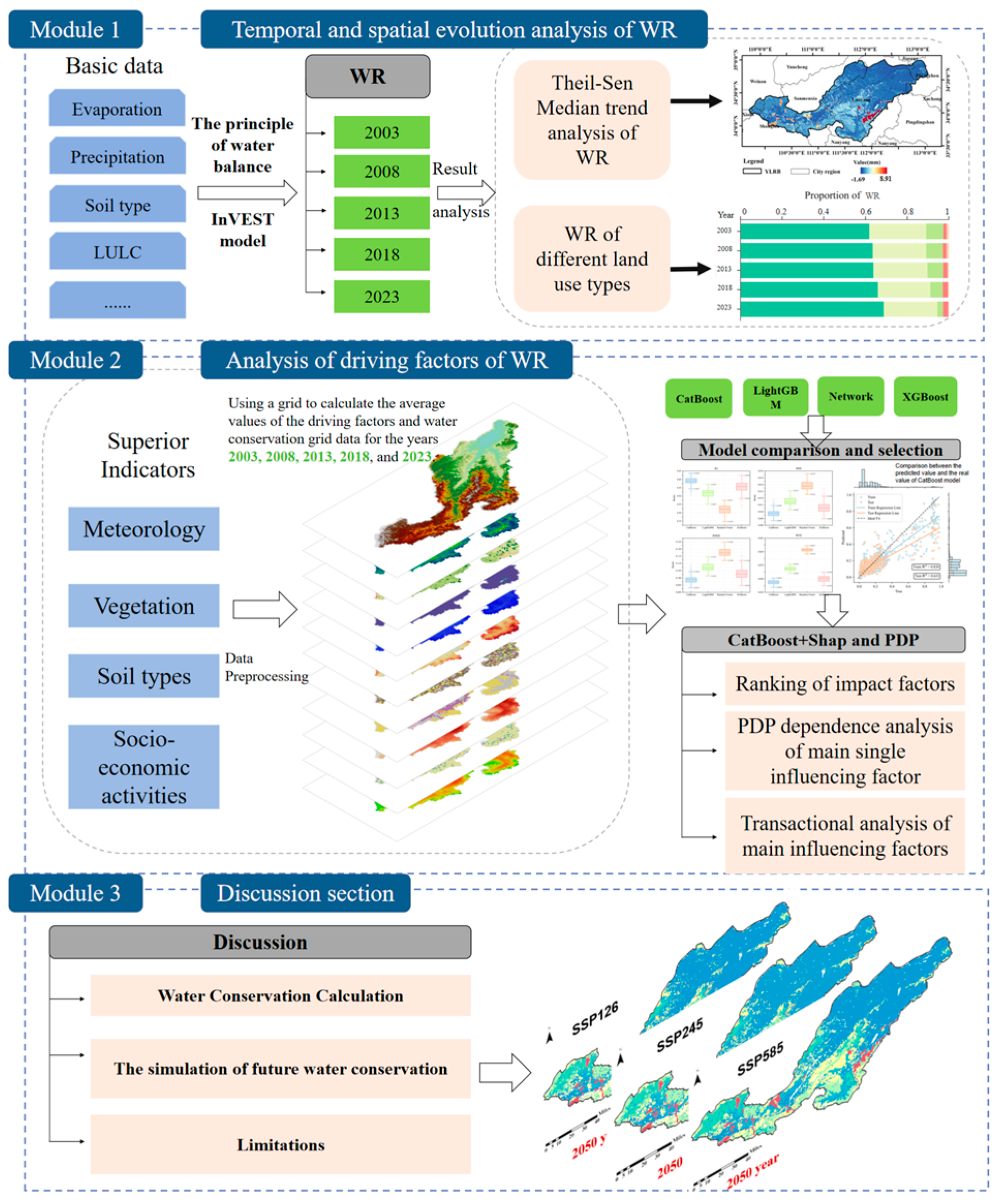
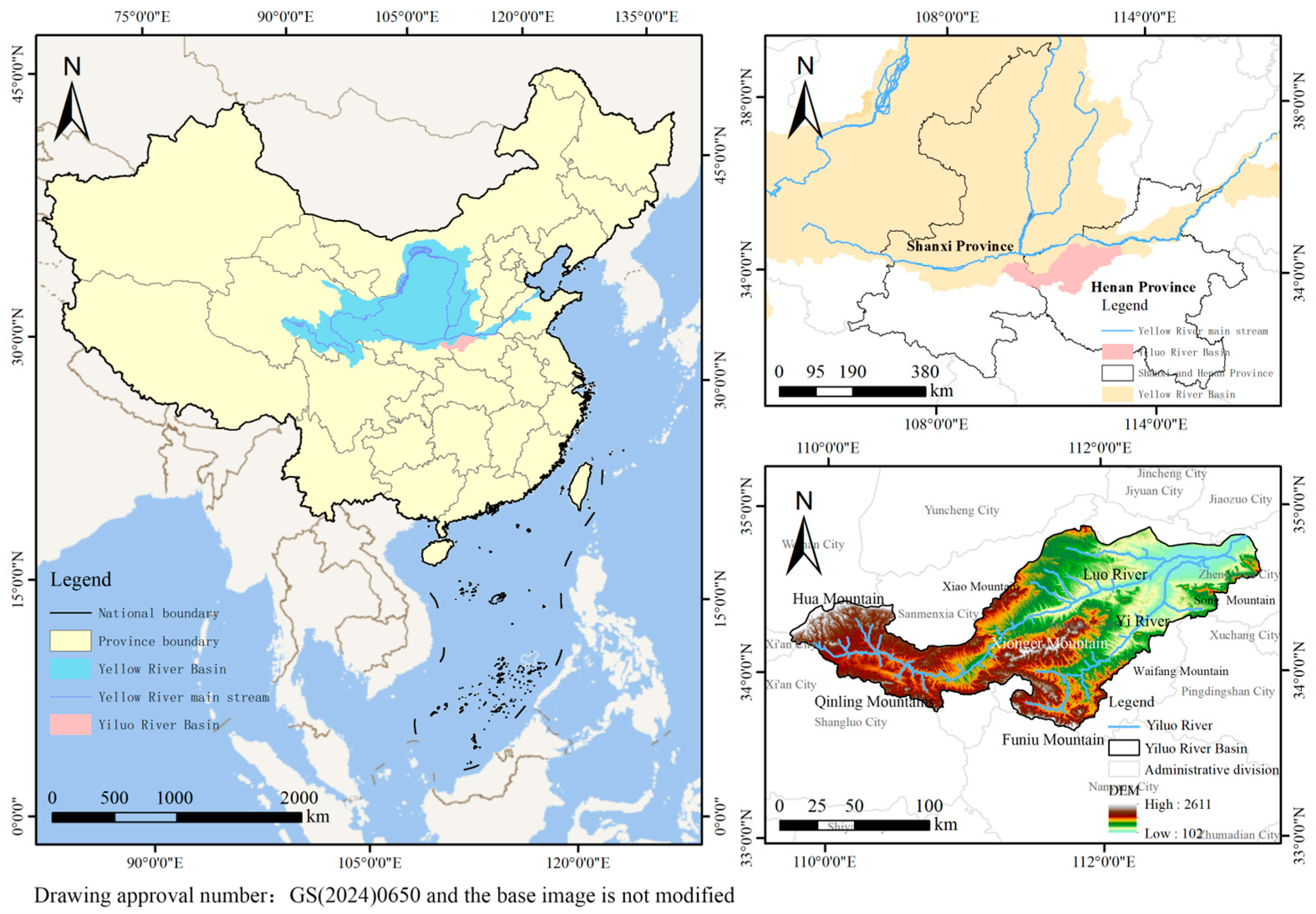
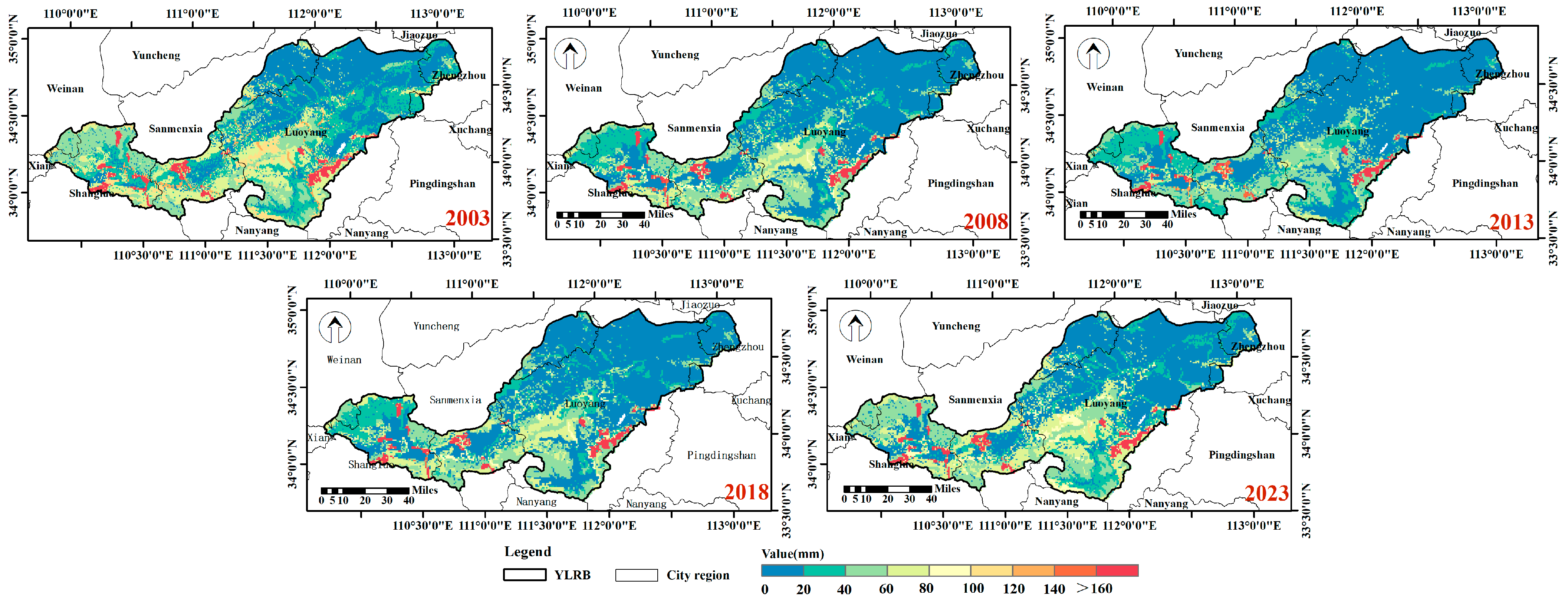
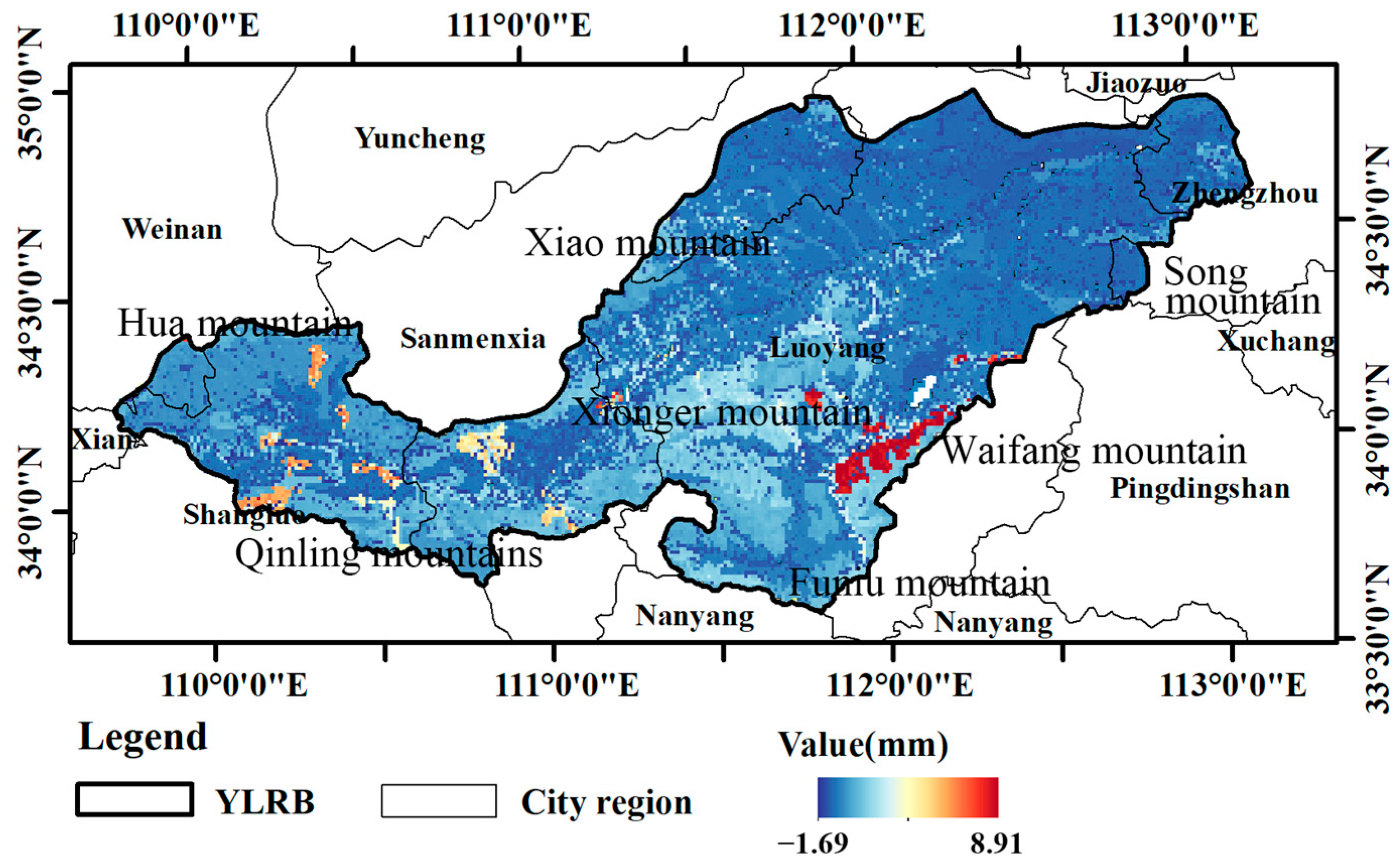
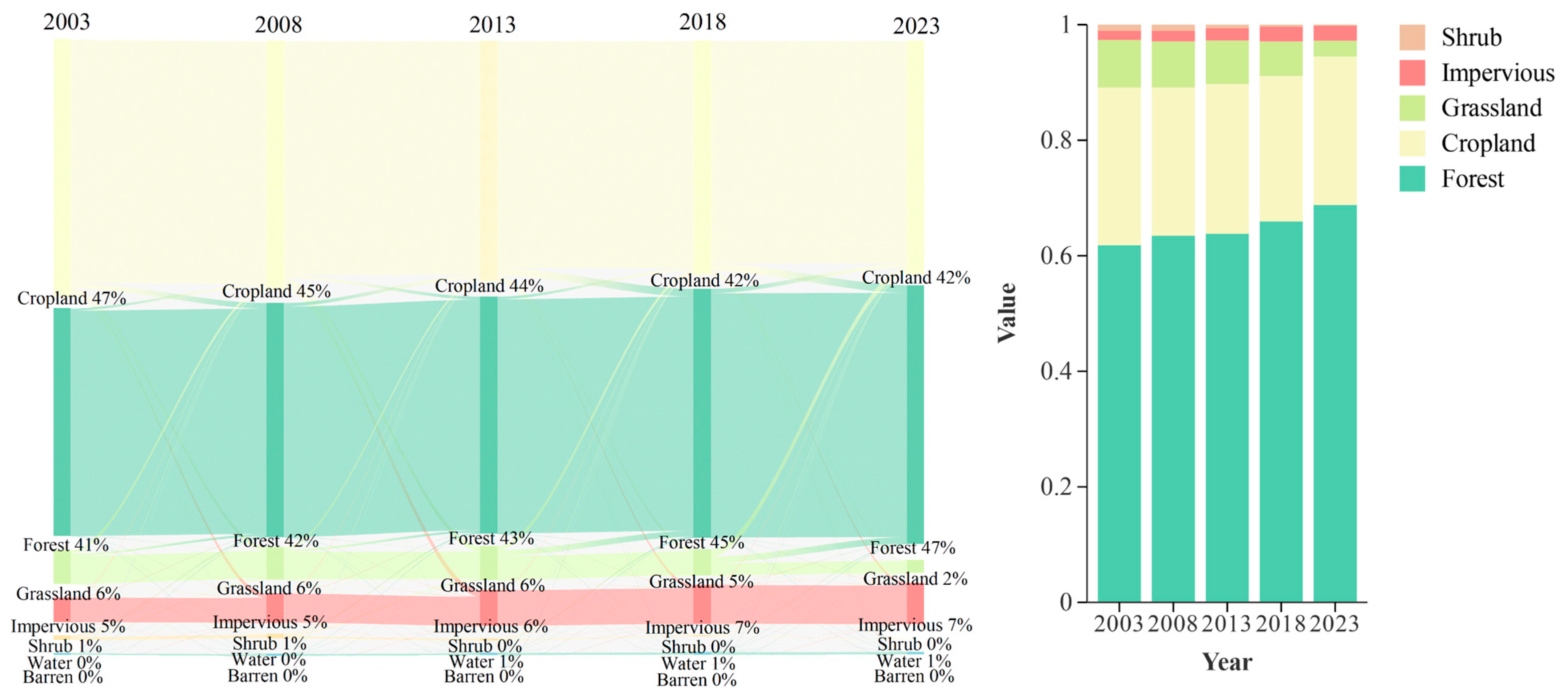
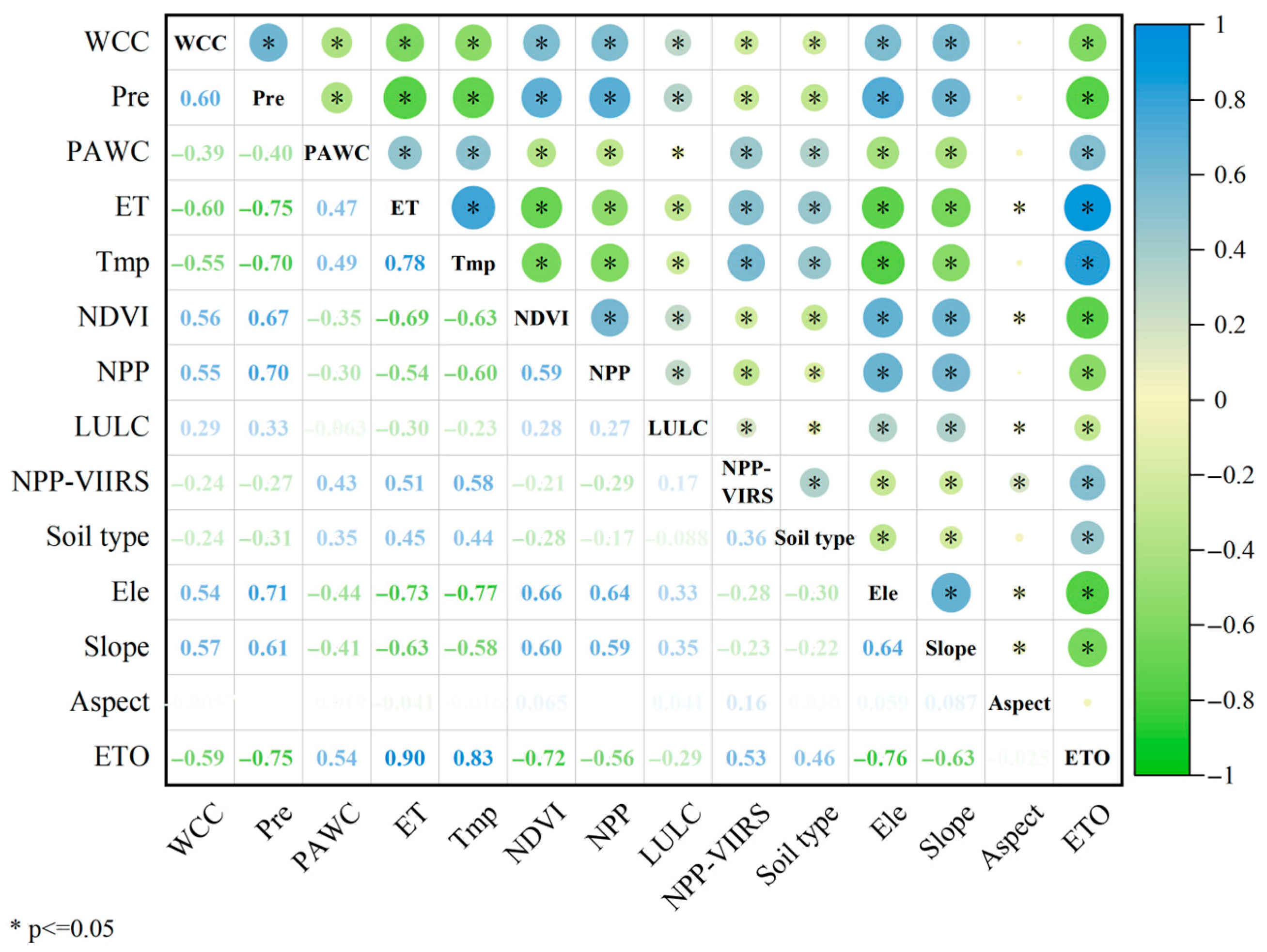
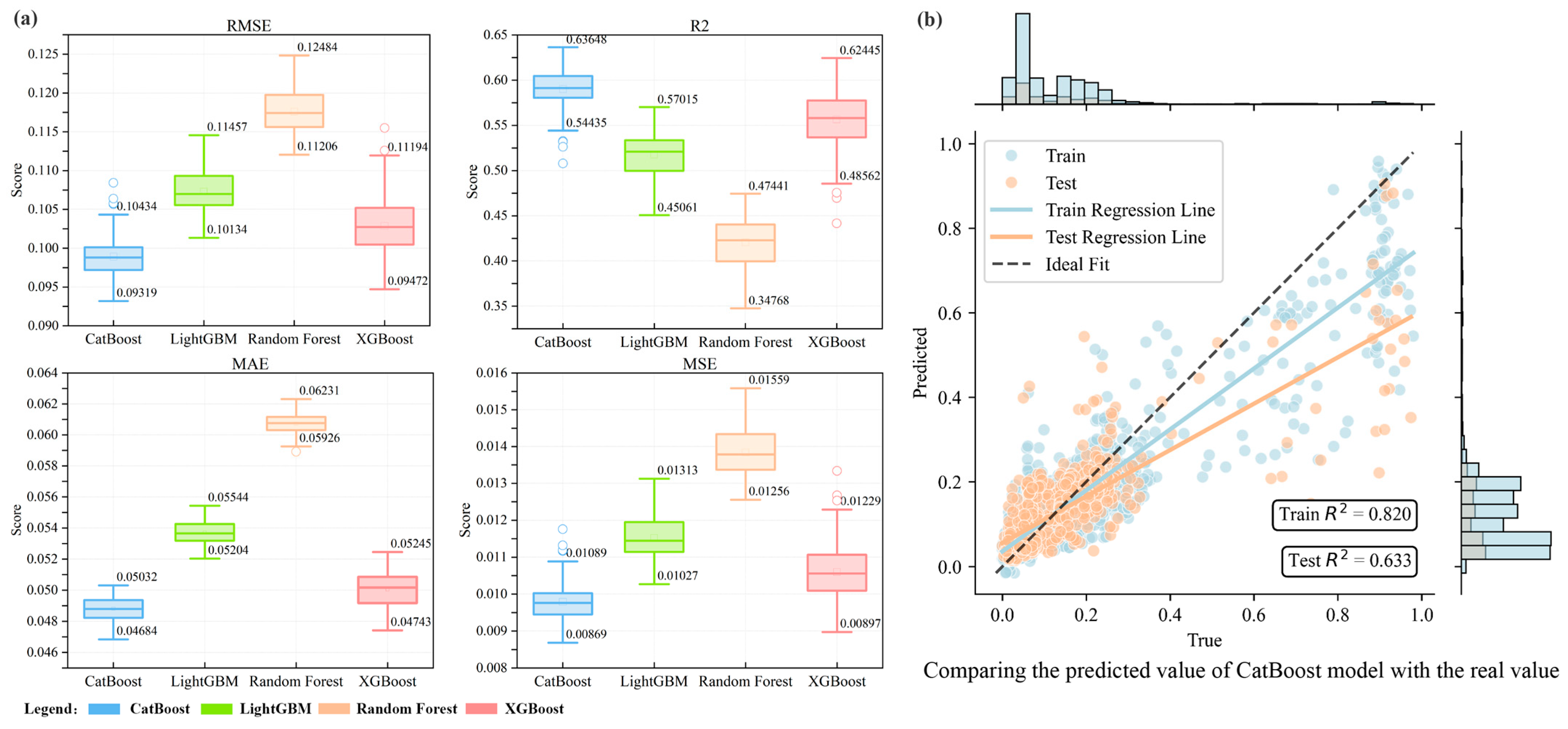
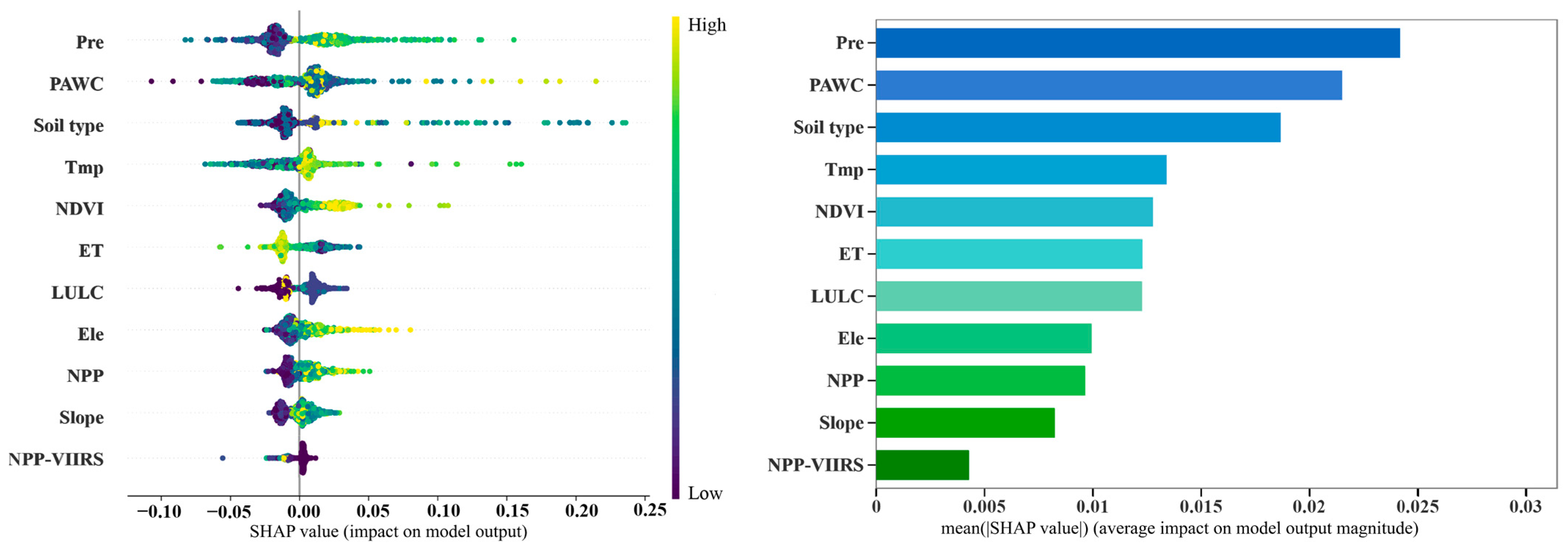
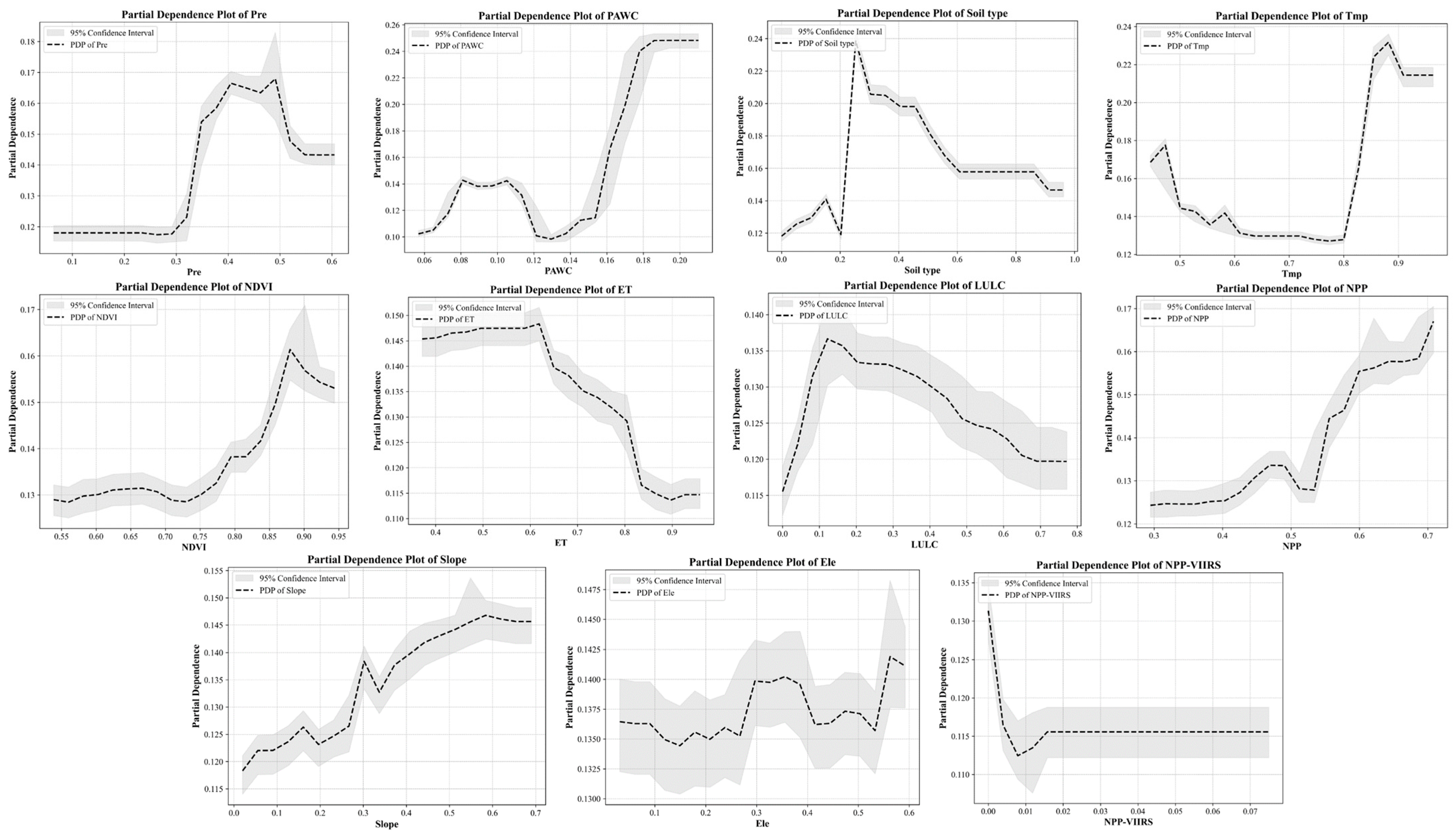
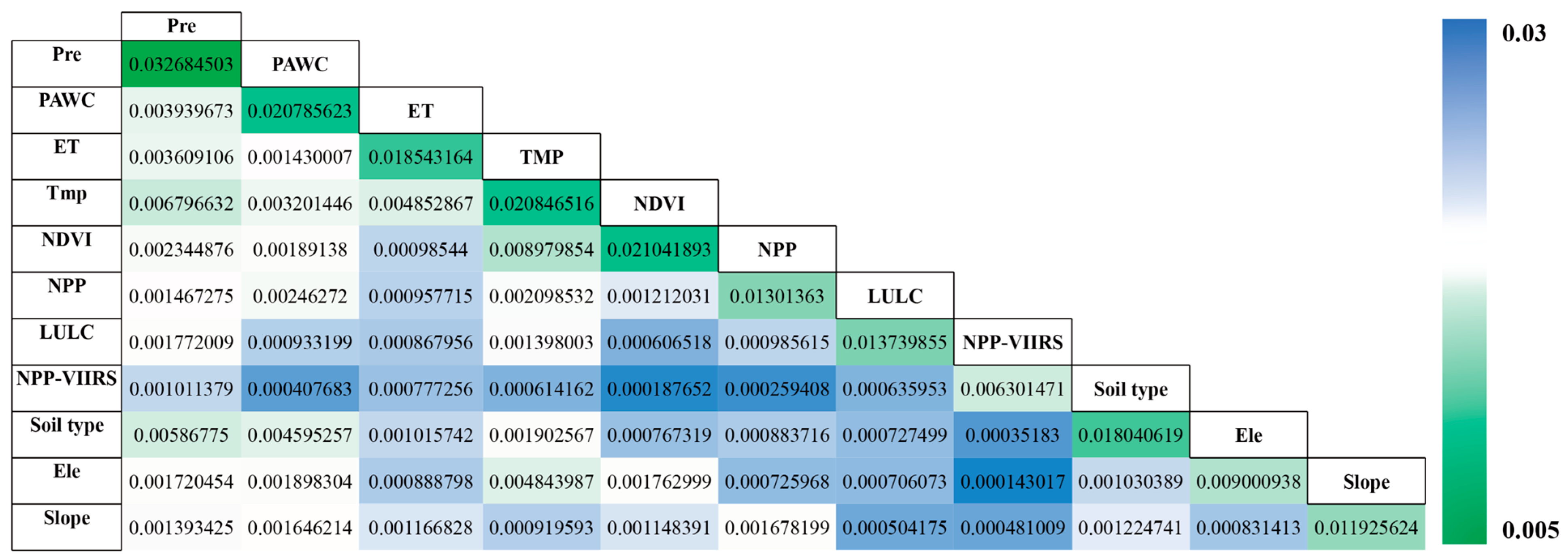
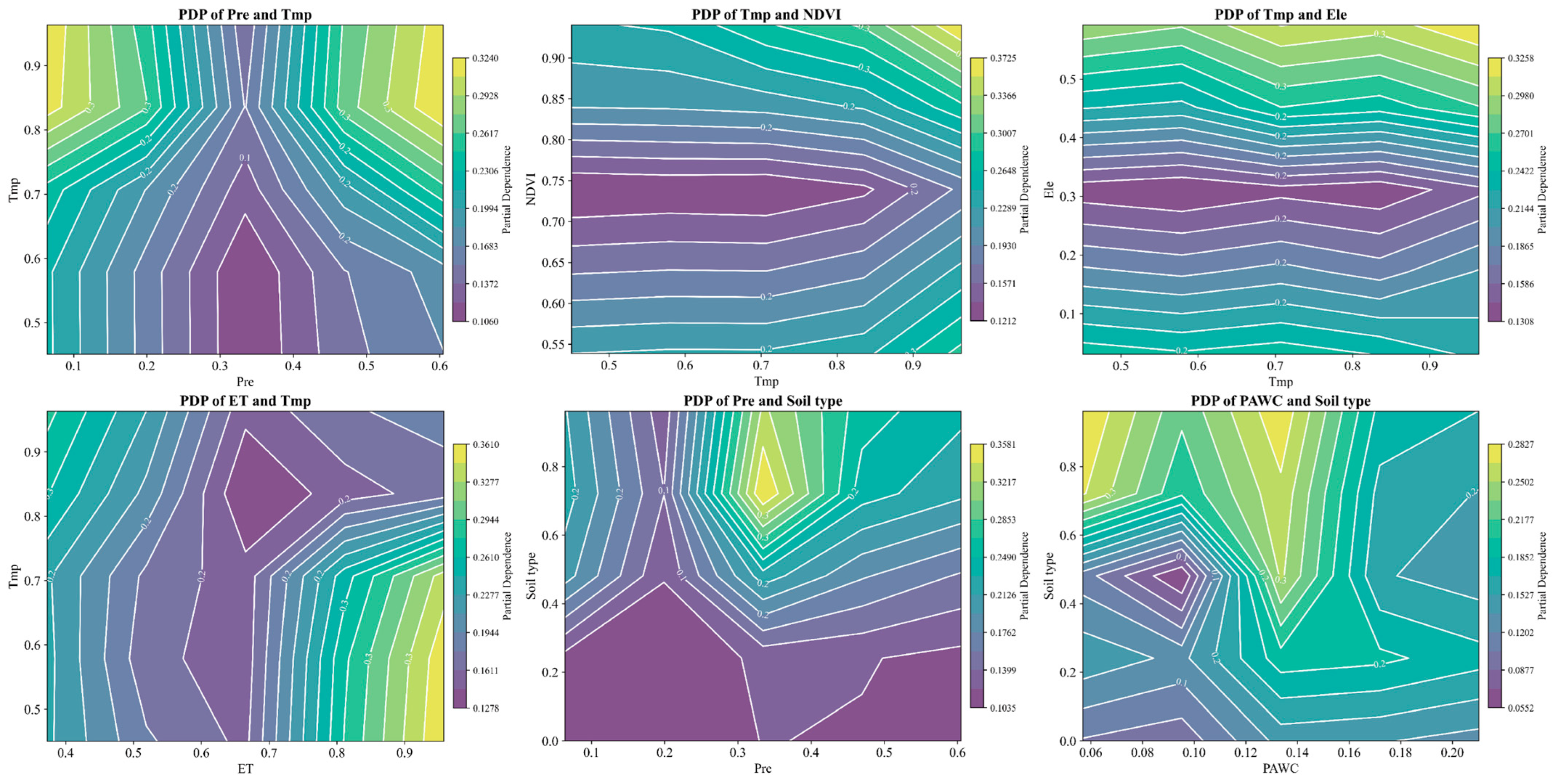

| Specific Data | Years | Resolution | Source |
|---|---|---|---|
| Land use/land cover maps | 2003, 2008, 2013, 2018, 2023 | 30 m | The 30 m annual land cover’s datasets and its dynamics in China from 1990 to 2021: CLCD [52], https://doi.org/10.5281/zenodo.8176941, (accessed on 2 February 2024). |
| Precipitation/evapotranspiration | 2003, 2008, 2013, 2018, 2023 | 1 km | Precipitation and evapotranspiration data included were obtained from the National Tibetan Plateau Science Data Center [53], https://data.tpdc.ac.cn, (accessed on 5 February 2024). |
| Root-restricting layer depth | 1 km | Depth-to-bedrock map of China at a spatial resolution of 100 meters [54], https://doi.org/10.6084/m9.figshare.11358929, (accessed on 10 February 2024). | |
| Plant available water content | 2003, 2008, 2013, 2018, 2023 | 1 km | The downloaded soil data were used to calculate the effective water content of plants according to the following formula [55]: where PAWC is plant available water content, is soil sand content, is soil silt content, is soil clay content, and is soil organic matter content. |
| Soil data | 1 km | Soil data from the World Soil Database: HWSD v2.0 [56], https://gaez.fao.org/pages/hwsd (accessed on 7 February 2024). | |
| Elevation | 30 m | The dataset is provided by the Data Center for Resources and Environmental Sciences, Chinese Academy of Sciences (RESDC) [57], http://www.resdc.cn, (accessed on 12 February 2024). | |
| Future climate data | 2050 | 1.12° × 1.12° | ERA5-CMIP6 climate projections [58], https://esgf-node.llnl.gov/projects/cmip6/, (accessed on 12 April 2024). |
| Future land use data | 2050 | 1 km | Obtained from Gridded 1 km Land Use/Land Cover Change Projections of China Under Comprehensive SSP-RCP Scenarios [59], http://www.geosimulation.cn/, (accessed on 16 April 2024). |
| Factor Type | Impact Factors | Years | Resolution | Data Source |
|---|---|---|---|---|
| Topography | Slope | 30 m | The data are provided by the Data Center for Resources and Environmental Sciences, Chinese Academy of Sciences (RESDC) [57], http://www.resdc.cn, (accessed on 12 February 2024). | |
| Aspect | 30 m | |||
| Elevation | 30 m | |||
| Soil | Soil Type | 1 km | Soil data from the World Soil Database, HWSD v2.0 [56], https://gaez.fao.org/pages/hwsd, (accessed on 7 February 2024). | |
| Vegetation | Plant Water Content | 2003, 2008, 2013, 2018, 2023 | 1 km | The data are calculated by the InVEST model. |
| Crop Evapotranspiration | 2003, 2008, 2013, 2018, 2023 | 1 km | ||
| Normalized Difference Vegetation Index | 2003, 2008, 2013, 2018, 2023 | 250 m | Obtained from National Tibetan Plateau, China regional 250 m normalized difference vegetation index dataset (2000–2023) [63], https://cstr.cn/18406.11.Terre.tpdc.300328, (accessed on 2 March 2024). | |
| Net Primary Productivity | 2003, 2008, 2013, 2018, 2023 | 500 m | NASA EOSDIS Land Processes Distributed Active Archive Center [64], https://doi.org/10.5067/MODIS/MOD17A3HGF.061, (accessed on 3 March 2024). | |
| Socioeconomic | Land Use Classification Data | 2003, 2008, 2013, 2018, 2023 | 30 m | The 30 m annual land cover’s datasets and its dynamics in China from 1990 to 2021: CLCD [52], https://doi.org/10.5281/zenodo.8176941, (accessed on 2 February 2024). |
| Nighttime Light Data | 2003, 2008, 2013, 2018, 2023 | 500 m | The National Earth System Science Data Center, National Science and Technology Infrastructure of China [65], http://www.geodata.cn, (accessed on 2 February 2024). | |
| Meteorological | Precipitation | 2003, 2008, 2013, 2018, 2023 | 1000 m | Precipitation, temperature, and evapotranspiration data were included, obtained from the National Tibet an Plateau Science Data Center [54], https://data.tpdc.ac.cn, (accessed on 5 February 2024). |
| Evapotranspiration | 2003, 2008, 2013, 2018, 2023 | 1000 m | ||
| Temperature | 2003, 2008, 2013, 2018, 2023 | 1000 m |
Disclaimer/Publisher’s Note: The statements, opinions and data contained in all publications are solely those of the individual author(s) and contributor(s) and not of MDPI and/or the editor(s). MDPI and/or the editor(s) disclaim responsibility for any injury to people or property resulting from any ideas, methods, instructions or products referred to in the content. |
© 2025 by the authors. Licensee MDPI, Basel, Switzerland. This article is an open access article distributed under the terms and conditions of the Creative Commons Attribution (CC BY) license (https://creativecommons.org/licenses/by/4.0/).
Share and Cite
Jia, Y.; Zhang, Z.; Huang, C.; Xie, S. Analysis of Water Source Conservation Driving Factors Based on Machine Learning. Sustainability 2025, 17, 1713. https://doi.org/10.3390/su17041713
Jia Y, Zhang Z, Huang C, Xie S. Analysis of Water Source Conservation Driving Factors Based on Machine Learning. Sustainability. 2025; 17(4):1713. https://doi.org/10.3390/su17041713
Chicago/Turabian StyleJia, Yixuan, Zhe Zhang, Chunhua Huang, and Shuibo Xie. 2025. "Analysis of Water Source Conservation Driving Factors Based on Machine Learning" Sustainability 17, no. 4: 1713. https://doi.org/10.3390/su17041713
APA StyleJia, Y., Zhang, Z., Huang, C., & Xie, S. (2025). Analysis of Water Source Conservation Driving Factors Based on Machine Learning. Sustainability, 17(4), 1713. https://doi.org/10.3390/su17041713





